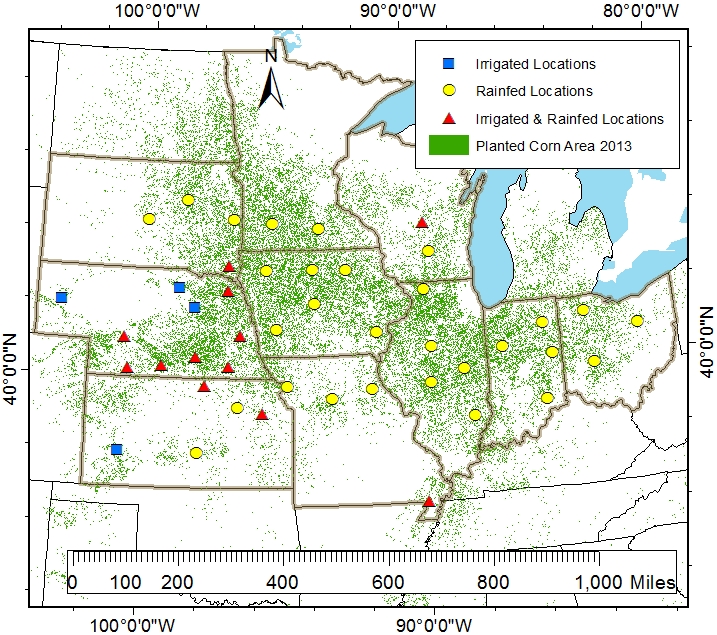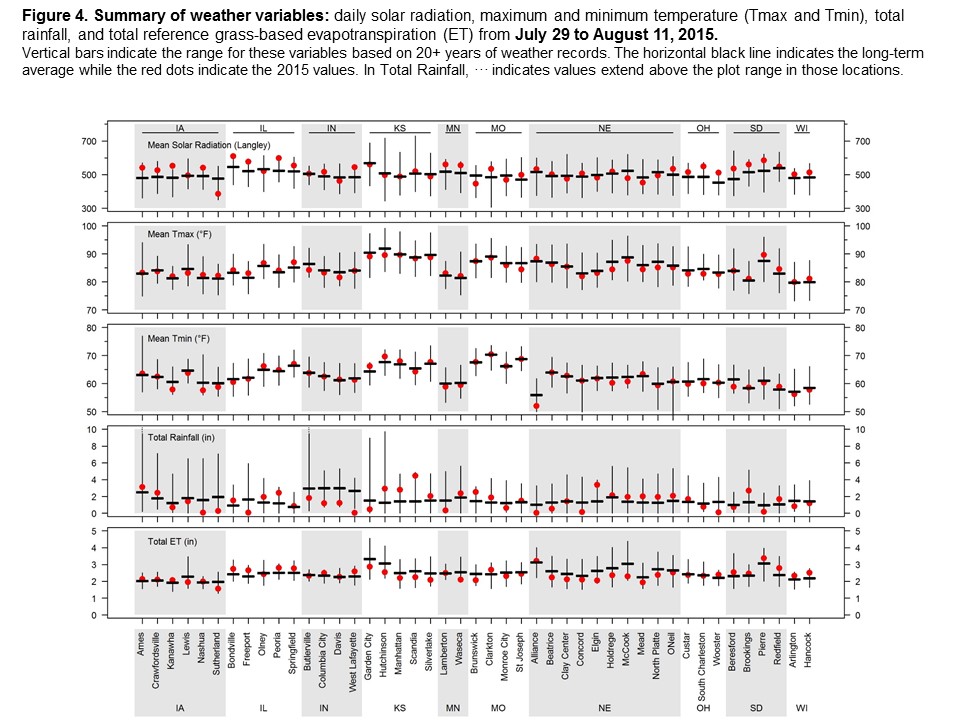2015 Forecasted Corn Yields Based on August 12 Hybrid Maize Simulations
Aug. 14, 2015

Figure 1. Locations used to simulate 2015 forecasted corn yields using Hybrid Maize.
See corn yield projections, as of Aug. 12, for these sites in Tables 3-5.
Grain filling is underway throughout Nebraska and the Corn Belt, except at the Hutchinson, Kan. dryland location where maturity was reached on August 12. During the two weeks since the last assessment of end-of-season corn yield potentials (July 29 forecast), weather conditions have remained close to the long-term means at most of the locations.
To evaluate changes in the 2015 end-of-season corn yield potential, additional simulations were performed on August 12 for the same 45 locations (Figure 1) using the UNL Hybrid-Maize model in collaboration with faculty and extension educators from 10 universities. Details about Hybrid-Maize and the underpinning methodology to forecast end-of-season yields, as well as information on interpreting and using yield forecasts, is in a previous CropWatch article.
Briefly, the Hybrid-Maize model simulates daily corn growth and development and final grain yield under irrigated and dryland conditions. The model estimates "yield potential," which is the yield obtained when the crop is not limited by nutrient deficiencies, diseases, insect pressure, or weed competition, conditions that represent an "optimal management" scenario. It also assumes a uniform plant stand at the specified plant population, and no problems from flooding or hail. Because weather, soil, and management factors are "location-specific," Hybrid-Maize simulations are based on actual weather data, soil, and typical management practices at the location being simulated as provided by university agronomists, extension educators, and DuPont Pioneer agronomists in each state (see Tables 1-2). Aug. 12 simulation results for end-of-season yields are shown in Tables 3-5.
The range of forecasted irrigated yields has narrowed slightly in relation to those forecasted two weeks ago on July 29. The probabilities of below-average irrigated yields continue to be low while probabilities of above-average yields increased in northern Nebraska (O'Neil and Elgin), similar to the nearby irrigated sites in South Dakota (Beresford). In Missouri, Wisconsin, and Kansas, a reduction in the probabilities of below-average yields from July 29 estimates has occurred. The range of final yields remains wide in relation to the uncertainty of the completion of the crop growth and development. In thinking about this, Figure 2 reports the probability of occurrence of early killing frost in the different irrigated locations, for the management, hybrid maturities, and planting dates under consideration. The yield gap range in the 25-75th percentiles is between 34 and 48 bushels per acre in those locations with a high probability of an early killing frost (Alliance, North Platte, Concord, Elgin and O'Neil). In those locations with a lower probability of an early killing frost, the gap is between 25 and 36 bushels per acre.
For dryland, the yield outlooks continue to increase. There is a high probability of near- or above-average yield (> 80%) at 33 of the 41 dryland sites, and a probability higher than 95% in 30 sites. The number of locations with a high probability of above-average dryland yields (>66%) continues increasing from 8 on July 15 to 14 locations on July 29, and 17 on August 12. However, in the western Corn Belt, eight locations have probabilities of below-average yields equal or above 20%. The probability of below-average yields is low to very low, unless unusual harsh weather conditions occur.

A summary of recent weather conditions (daily solar radiation, maximum and minimum temperature, total rainfall, and total (grass-based) reference evapotranspiration [ET]) from July 29 to August 11 is presented in Figure 4 to help interpret the simulated yields and changes in estimations. Vertical bars indicate the range for these variables based on more than 20 years of weather records. The horizontal thick line indicates the long-term average while the red dots indicate the 2015 averages.
In northern locations in Iowa, Illinois and Indiana, rainfall has been scarce in the last two weeks (July 29 through August 11), however, the range of yields and probability distributions of end-of-season scenarios remained unchanged in most locations, since water demand is likely being satisfied by accumulated water in the soil profile from abundant rainfall in July. (See June 15-July 15 and July 15-July 29 weather data.) Daytime temperatures have been close to normal throughout the Corn Belt, with nighttime temperatures remaining near normal. In addition, reference ET has remained close to or slightly below normal throughout the entire region (Nebraska and Kansas). The probability of an early killing frost on later maturing hybrids is likely (>50%) at the Minnesota and Wisconsin sites as well as the northern Iowa locations, as well as in Concord and North Platte (Figure 3). As grain filling progresses and observed weather data become available, the range of forecasted yields will continue to narrow.
Conclusions
In most of the irrigated locations across the Corn Belt, there is a high probability of yields being close to or above long-term average yields, with uncertainty related to the completion of grain filling and in some locations, occurrence of an early killing frost during later growth stages.
These forecasts do not take into consideration problems with stand emergence due to residue, hail/flooding damage, replanting situations, disease/insect issues, or nutrient deficiencies. Therefore, in fields negatively affected by these constraints, actual yields will be lower than these estimates. We will follow up in late August with updated forecasts including updated estimates of the range of dates for physiological maturity and estimation for the probability of an early killing frost in each location.
Readers also may want to view USDA corn yield estimates released earlier this week. (See Nebraska estimates and US estimates.)
Francisco Morell, UNL Post-doctoral Research Associate
Patricio Grassini, UNL Assistant Professor of Agronomy and Horticulture, Extension Cropping System Specialist and Water for Food Institute Fellow
Haishun Yang, UNL Associate Professor of Agronomy and Horticulture and Water for Food Institute Fellow
Kenneth Cassman, UNL Professor of Agronomy and Horticulture and Robert B. Daugherty Water for Food Institute Fellow
Roger Elmore, UNL Professor of Agronomy and Horticulture, Extension Cropping System Specialist and Water for Food Institute Fellow
Justin Van Wart, UNL Post-doctoral Research Associate
Keith Glewen, Nebraska Extension Educator
Jennifer Rees, Nebraska Extension Educator
Greg Kruger, UNL Assistant Professor of Agronomy and Horticulture and UNL Extension Cropping System Specialist
Charles Shapiro, UNL Extension Soils Scientist – Crop Nutrition and Professor of Agronomy and Horticulture
Ignacio Ciampitti, Crop Production and Cropping System Specialist and Assistant Professor of Agronomy, Kansas State University
Mark Licht, Extension Cropping System Agronomist, Iowa State University
Peter Thomison, Extension Specialist and Professor, Ohio State University
Joe Lauer, Professor, University of Wisconsin-Madison
Sylvie Brouder & Tony Vyn, Professors of Agronomy, Purdue University
Ray Massey, Extension Professor, University of Missouri
Cameron Pittelkow, Assistant Professor, University of Illinois
Chris Graham, Assistant Professor, South Dakota State University
Jeff Coulter, Associate Professor and Extension Specialist, University of Minnesota
Online Master of Science in Agronomy
With a focus on industry applications and research, the online program is designed with maximum flexibility for today's working professionals.
